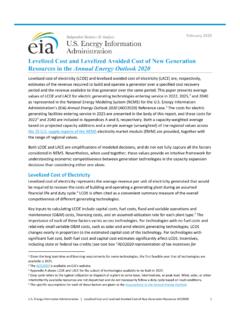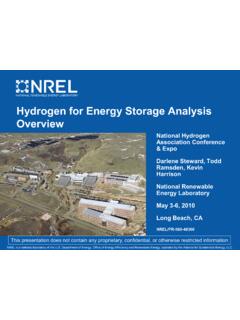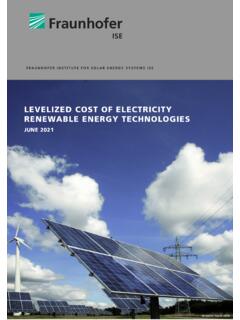Transcription of U.S. Solar Photovoltaic System and Energy Storage Cost ...
1 NREL is a national laboratory of the Department of Energy Office of Energy Efficiency & Renewable Energy Operated by the Alliance for Sustainable Energy , LLC This report is available at no cost from the National Renewable Energy Laboratory (NREL) at Contract No. DE-AC36-08GO28308 Technical Report NREL/TP-7A40-80694 November 2021 Solar Photovoltaic System and Energy Storage cost Benchmarks: Q1 2021 Vignesh Ramasamy, David Feldman, Jal Desai, and Robert Margolis NREL is a national laboratory of the Department of Energy Office of Energy Efficiency & Renewable Energy Operated by the Alliance for Sustainable Energy , LLC This report is available at no cost from the National Renewable Energy Laboratory (NREL) at Contract No. DE-AC36-08GO28308 National Renewable Energy Laboratory 15013 Denver West Parkway Golden, CO 80401 303-275-3000 Technical Report NREL/TP-7A40-80694 November 2021 Solar Photovoltaic System and Energy Storage cost Benchmarks: Q1 2021 Vignesh Ramasamy, David Feldman, Jal Desai, and Robert Margolis Suggested Citation Ramasamy Vignesh, David Feldman, Jal Desai, and Robert Margolis.
2 2021. Solar Photovoltaic System and Energy Storage cost Benchmarks: Q1 2021. Golden, CO: National Renewable Energy Laboratory. NREL/TP-7A40-80694. NOTICE This work was authored by the National Renewable Energy Laboratory, operated by Alliance for Sustainable Energy , LLC, for the Department of Energy (DOE) under Contract No. DE-AC36-08GO28308. Funding provided by the Department of Energy Office of Energy Efficiency and Renewable Energy Solar Energy Technologies Office. The views expressed herein do not necessarily represent the views of the DOE or the Government. This report is available at no cost from the National Renewable Energy Laboratory (NREL) at Department of Energy (DOE) reports produced after 1991 and a growing number of pre-1991 documents are available free via Cover Photos by Dennis Schroeder: (clockwise, left to right) NREL 51934, NREL 45897, NREL 42160, NREL 45891, NREL 48097, NREL 46526.
3 NREL prints on paper that contains recycled content. iii This report is available at no cost from the National Renewable Energy Laboratory (NREL) at List of Acronyms AC alternating current BESS battery Energy Storage System BLS Bureau of Labor Statistics BOS balance of System CAPEX capital expenditures DC direct current DOE Department of Energy EPC engineering, procurement, and construction HVAC heating, ventilating, and air conditioning LCOE levelized cost of Energy LCOS levelized cost of Storage LCOSS levelized cost of Solar -plus- Storage Li-ion lithium-ion MWAC megawatts alternating current MWDC megawatts direct current NREL National Renewable Energy Laboratory O&M operation and maintenance OPEX operating expenditures PII permitting, inspection, and interconnection PV Photovoltaic (s) Q quarter RTE round-trip efficiency SG&A selling, general, and administrative SOC state of charge USD dollars VDC volts direct current WAC watts alternating current WDC watts direct current iv This report is available at no cost from the National Renewable Energy Laboratory (NREL) at Executive Summary This report benchmarks installed costs for Solar Photovoltaic (PV) systems as of the first quarter of 2021 (Q1 2021).
4 We use a bottom-up method, accounting for all System and project development costs incurred during installation to model the costs for residential, commercial, and utility-scale PV systems, with and without Energy Storage . We attempt to model typical installation techniques and business operations from an installed- cost perspective. Costs are represented from the perspective of the developer/installer; thus, all hardware costs represent the price at which components are purchased by the developer/installer and do not account for preexisting supply agreements or other contracts. Importantly, the benchmarks also represent the sales price paid to the installer. Therefore, they include profit in the cost of the hardware;1 the profit the installer/developer receives is reported as a separate cost category on top of all other costs to approximate the final retail price paid to the installer/developer.
5 Benchmarks also assume a business environment without any impact from the novel coronavirus pandemic. Finally, our benchmarks are national averages calculated using average values across all states. Table ES-1 summarizes the first-order benchmarking assumptions. Table ES-1. Benchmarking Assumptions Unit Description Values 2020 dollars (USD)a System sizes PV systems are quoted in direct current (DC) terms; inverter prices are converted by DC-to-alternating current (AC) ratios; residential Storage systems are quoted in terms of nameplate kilowatt-hours and commercial/utility Storage systems are quoted in terms of usable kilowatt-hours or megawatt-hours (kWh or MWh) of Storage or the number of hours of Storage at peak capacity. PV Sector Description Size Range Residential Residential rooftop systems, monocrystalline silicon modules 3 kW 11 kW Commercial Commercial rooftop with ballasted racking and fixed-tilt ground-mounted systems, monocrystalline silicon modules 100 kW 2 MW Utility-scale Ground-mounted systems, monocrystalline silicon modules, fixed-tilt and one-axis tracking 5 100 MW a The dollar-per-watt total cost values are benchmarked as two significant figures, because the model inputs, such as module and inverter prices, use two significant figures.
6 Based on our bottom-up modeling, the Q1 2021 PV and Energy Storage cost benchmarks are those listed in Table ES-2: 1 Profit is one of the differentiators of cost (aggregated expenses incurred by a developer or installer to build a System ) and price (what an end user pays for a System ). v This report is available at no cost from the National Renewable Energy Laboratory (NREL) at Table ES-2. Q1 2021 PV and Energy Storage cost Benchmarks cost Benchmarksa PV System Residential Systems $ (or $ ) rooftop PV $ $ rooftop PV with 5 kWhb nameplate of Storage Commercial Systems $ (or $ ) 200-kWDC rooftop PV $ (or $ ) 500-kWDC ground-mounted PV $ $ 1-MWDC ground-mounted PV colocated with 600 MWhusable of Storage Utility-Scale Systems $ (or $ ) 100-MWDC fixed-tilt utility-scale PV $ (or $ ) 100-MWDC one-axis-tracking utility-scale PV $ $ 100-MWDC one-axis tracker PV colocated with 60 MWDC/240 MWhusable of Storage a cost /Watt DC (WDC) of PV-plus- Storage systems are estimated using PV capacity to reflect the additional cost required to install hybrid systems over installing stand-alone PV systems.
7 The cost range shows the difference in cost between DC-coupled and AC-coupled systems. b All Energy Storage capacity rating mentioned in this report are in DC. It should be noted that the interconnection capacity of all these systems is assumed to be equal to the total AC capacity of the System . All data relevant to the reported results in this report can be found in the NREL Data Figure ES-1 (page vi) compares our Q1 2021 PV-only benchmarking results to the Q1 2020 National Renewable Energy Laboratory benchmarking Between 2020 and 2021, there were ($ ), ($ ), and ($ ) reductions (in 2020 USD) in the residential, commercial rooftop, and utility-scale (one-axis) PV System cost benchmarks respectively. Balance of System (BOS) costs have either increased or remained flat across sectors, year-on-year, unlike in previous benchmarking reports, which generally have reported declining BOS costs.
8 The increase in BOS cost has been offset by a 19% reduction (in 2020 USD) in module cost . Overall, modeled PV installed costs across the three sectors have declined compared to our Q1 2020 System costs. Table ES-3 shows the benchmarked values for all three sectors and the drivers of cost decreases and increases. 2 Data File ( Solar Photovoltaic BESS System cost Benchmark Q1 2020 Report) NREL, 3 Appendix B summarizes benchmark results for all previous NREL benchmark analyses (2010 2021). vi This report is available at no cost from the National Renewable Energy Laboratory (NREL) at Figure ES-1. Comparison of Q1 2020 and Q1 2021 PV cost benchmarks BOS is balance of System ; PII is permitting, inspection, and interconnection. Table ES-3. Comparison of Q1 2020 and Q1 2021 PV System cost Benchmarks Sector Residential PV Commercial Rooftop PV Utility-Scale PV, One-Axis Tracking Q1 2020 benchmarks in 2019 USD/WDC $ $ $ Q1 2021 Benchmarks in 2020 USD/WDC $ $ $ Drivers of cost reduction Higher module efficiency (from to ) Lower module cost Higher module efficiency Lower module cost Higher module efficiency Lower module cost Drivers of cost increment Higher Inverter price Higher labor wage Higher material and equipment cost Higher labor wage Higher material and equipment cost Higher labor wage Higher steel price Higher material and equipment cost vii This report is available at no cost from the National Renewable Energy Laboratory (NREL) at Figure ES-2 shows the difference between Q1 2021 and Q1 2020 benchmark values adjusted for comparison.
9 In addition to changing the dollar year from 2019 to 2020, we adjusted Q1 2020 values to have the same size Storage capacity as the current Q1 2021 sizes to better demonstrate cost changes between years. Figure ES-2. Comparison of Q1 2020 and Q1 2021 stand-alone BESS cost benchmarks In previous benchmarking reports, across all sectors, Storage System costs were represented in nameplate capacity but this year only the residential Storage System cost is represented in nameplate capacity while commercial and utility scale Storage System costs are represented in usable capacity. The Additional cost from model updates category for Q1 2020 commercial and utility-scale systems represents the increase in cost that is due to adding Storage capacity to keep the same values (600 kW/240 kWh, 60 MW/240 MWh) but is quoted in terms of usable capacity rather than nameplate capacity. Overbuilding battery capacity on the DC side is necessary to account for round-trip efficiency (RTE) loss and state of charge (SOC) limitations.
10 The Q1 2020 residential Storage capacity was also adjusted from previously benchmarked sizes of 5 kW/20 kWh and 3 kW/6 kWh to the Q1 2021 benchmarked sized of 5 kWh. Figure ES-3 shows approximately 6% and 3% reductions in residential PV-plus- Storage benchmark between 2020 and 2021 for DC-coupled and AC-coupled cases respectively. Most of these reductions can be attributed to reductions in the cost of PV modules and battery packs. The cost reductions occurred despite the rated capacity of the 22-module System increasing from kW to kW between 2020 and 2021. viii This report is available at no cost from the National Renewable Energy Laboratory (NREL) at Figure ES-3. Comparison of Q1 2020 and Q1 2021 residential PV-plus- Storage System cost Benchmarks The Q1 2020 residential Storage capacity was adjusted from previously benchmarked sizes of 5 kW/20 kWh and 3 kW/6 kWh to the Q1 2021 benchmarked sized of 5 kWh.


















